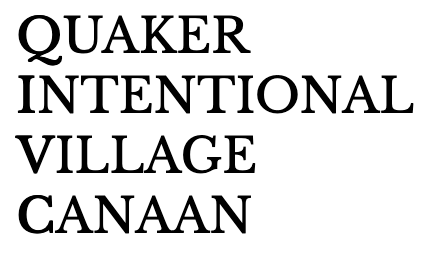We are often asked about the financial side of becoming a member of QIVC. Here is how it works, in brief. We know that finances are often tight, and so we try to be flexible if possible while still meeting the needs of both members and the community as a whole.
How is membership in QIVC structured?
Full membership at QIVC includes renter membership and homeowner membership, which include capital investment and, in the latter case, home ownership in the community.
How they differ:
- Homeowner members either purchase a house in the community or choose a building site and build a new home.
- When homeowner membership begins, homeowner members agree to make a required membership loan to QIVC equal to $30 per square foot of the home they are buying or building. This investment is most often made up front, but can be made via a payment plan acceptable to both the new members and QIVC. (The required membership loan is separate from the purchase or construction cost of the house, because it helps cover the cost of the land and any commonly owned improvements, such as driveways, septic systems, wells, and the Farmhouse.)
- Renter members rent a residence from QIVC, which owns the residence and serves as the lessor.
- When renter membership begins, renter members provide QIVC with a required membership loan equal to one month’s rent*, and begin paying a monthly amount to QIVC. Though part of the monthly payment may be used for capital expenses, renter members do not make a capital investment in QIVC and thus renter members do not have any claims of capital ownership. The amount of the monthly payment will be agreed to by the renter members and the community and may change over time.
QIVC also offers associate membership as a stepping stone to full membership and for those who prefer this lower level of commitment. See QIVC Steps in Membership.
How much does it cost to join QIVC and live here?
For homeowner members:
- After acceptance into membership, a required membership loan in the amount of $30/sq. ft. (in 2010) of your residence (e.g., $36,000 for a 1,200 sq. ft. home)
- Approximately $280,000 to build a simple 1,200 sq. ft. home or build your own simple 1,500 sq. ft. home. In addition, QIVC invests approximately $50,000 into site-improvement costs associated with a new house, which includes septic, well, and driveway. (These costs are usually split between two or more houses.)
- Annual QIVC dues of approximately $2,700 per year per adult for annual operating fees (covering property taxes on the land and our common structures, repayment of loans, insurance, maintenance, etc.), payable in installments worked out with our Financial Clerk (treasurer). In an annual Deliberation Forum, each member offers what they could contribute in annual operating fees - we see a big range - and we somehow always end up with plenty to meet our projected expenses.
- The annual property taxes on just your home, not on the land (approx. $4,000 per year for a 1,500 sq. ft. home, payable about 1/3 in January and 2/3 in September each year)
Note that we are often able to help new homeowners finance their purchase with very low-cost loans or mortgages held by other QIVC members and/or QIVC. To date, neither QIVC nor any individual members have had to take out commercial mortgages, and we hope to keep up that track record!
For renter members:
- After acceptance into membership, a one-time required membership loan equal to one month's rent*
- Annual QIVC dues, as described above for homeowners
- A monthly rental amount, which is reviewed annually with the commuity
Since QIVC owns and is responsible for all the driveways, parking areas, septic systems, and wells, the costs of maintaining them is shared, which provides a big savings at the household level.
Costs of typically available housing options:
- Build a home or have one built on the current available building site: $280,000 or more
- Rent a 3-bedroom house nearby on a temporary basis: $1,500-$2,200 per month
- Rent a Farmhouse room: $500-$700 per month
Other financial aspects of living as part of QIVC:
The part that's hard to represent are the savings you can realize from living in community, since they vary so much by each household's situation. Here are some examples, both large and small:
- Shared equipment: electric vehicle charging ports, mowers, snow plow, immersion blenders, chop saws and other construction tools, tractor with brush-hog, etc.
- Our own food production: garden space, gardening expertise, room to process food in Farmhouse
- Shared produce and other food
- Shared laundry room: make your house smaller and no need to buy your own expensive appliances
- Shared common space and guest room: allows you to design a smaller house
- Sometimes free childcare from other members
- Shared trips to the school-bus stop, shared rides to or from town, errand-sharing, child pick-up, carpooling
- Free loan of cars (e.g., you may have a sedan and need a minivan for the day, so you trade, or your car is in the shop while another household is out of town, so they let you use their car)
- Shared expenditure of energy or dollars for things like snowplowing
*This requirement for an initial loan from renter-members is under review (9-2025)

